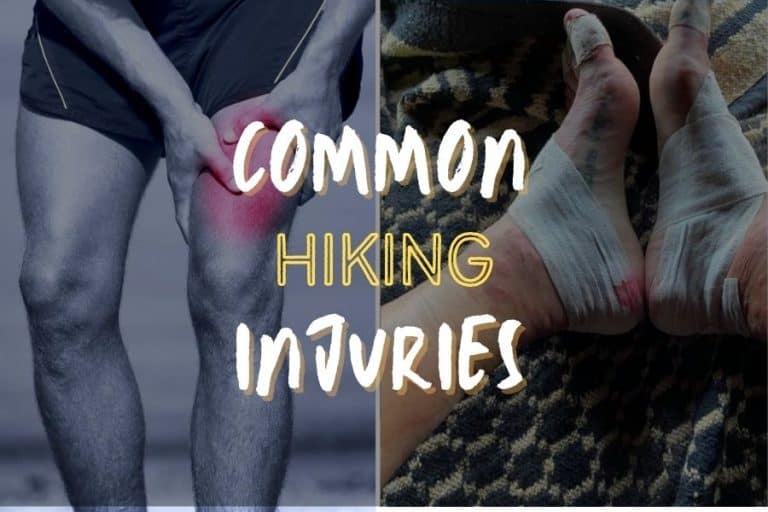Have you ever thought about hiking injuries?
We hear about hikers getting hurt, lost, and sometimes dying all the time.
We know there is a risk of injury if you don’t take the proper safety measures in the backcountry.
Nature is, for the most part, not controlled by humans. That means it can be brutal, unforgiving, and rugged.
The best thing we can do as hikers is to avoid injury as much as possible.
But that’s not always the case. I’ve had plenty of hiking injuries in the 12 years I’ve been hitting the trail, and I’m a seasoned hiker.
Anything can happen in the backcountry. We don’t know what’s always going to happen. But we know that preparedness is essential in responding to an injury.
And that’s what we’ll be looking at today – hiking injuries and how to treat them.
Table of Contents
ToggleWhat are common injuries while hiking?
Not every hiking injury can be listed in this article. This would turn into a book more than a blog post if they could.
However, the most common types of hiking injuries are as follows:
- Blisters
- Strains and Sprains
- Cuts
- Hypothermia
- Hyperthermia
- Dehydration
- Sunburn
- Bug Bits
- Broken Bones
These injuries have happened to me in the past, and some, I’m sure, have happened to you.
But there are probably some that haven’t happened, and with the following information, you’ll know what to do when they happen.
Blisters
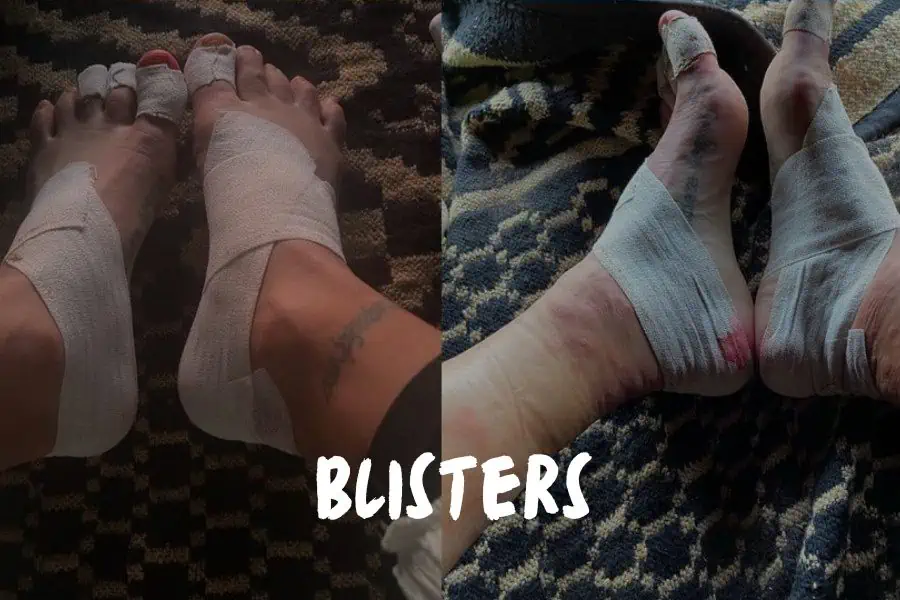
A blister is a painful condition of the skin that occurs when fluid fills a space between layers of the skin.
This is typically caused by selecting shoes or boots that are too small.
However, some properly fitting footwear can cause blisters if the footwear is very new and used on a longer hike.
You’ve heard the expression “break in your new hiking boots” before a long hike.
Breaking in new footwear before you go on longer and more rugged hikes is one of the best ways to prevent blisters.
Wet feet can also cause blisters, so keeping your feet as dry as possible is essential.
You might wear trail runners that get wet in the summer, try to find shoes that have good ventilation, and wear socks that help wicker away moisture.
How to treat a blister on a hike?
The best way to treat a blister and reduce the pain that it causes is to cover up the hot spot or the skin that is being impacted. Use a moleskin or a Band-Aid for this.
There has been a time when I haven’t had any good band-aids, and I’ve used duct tape as an alternative. It works.
It keeps the hot spot covered and prevents infection in case the blister ruptures.
You should avoid popping it but if it does rupture, try to put some antibiotic ointment on it to help mitigate infection and promote quicker healing.
Strains and Sprains
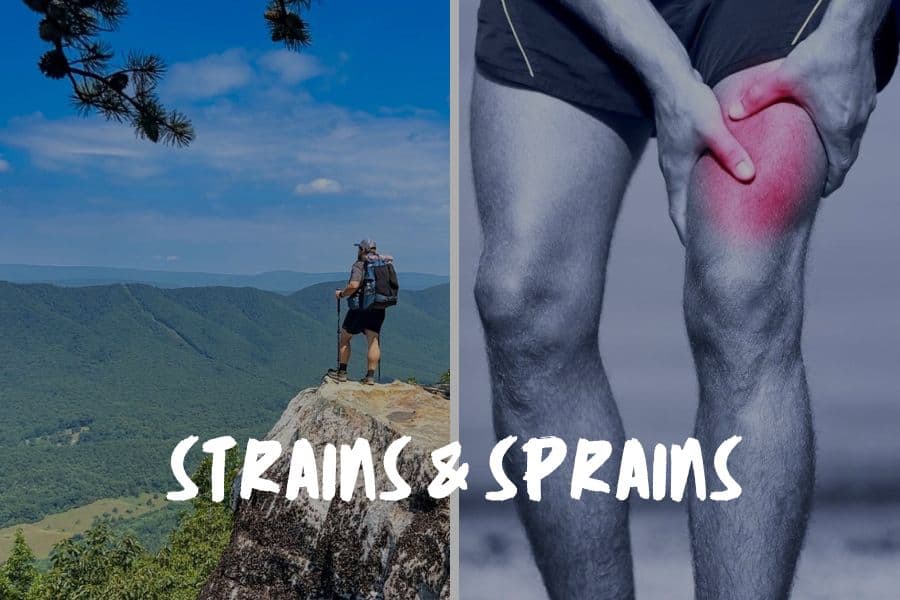
There is a difference between a strain and a sprain though the two are often used in the same context quite a bit.
A strain impacts your muscles, while a sprain impacts your ligaments and tendons.
For example, you could strain your back by not properly packing your day pack correctly. You can sprain your ankle if you misstep while on the trail.
Preventing strains and sprains is easy as long as you focus on preventing them.
One thing you should do is try to stay fit. Exercise routinely to help strengthen yourself as a hiker. I like to road bike as a way to improve my lower muscles.
It helps with hiking, especially hill climbing.
You must also stretch after you’ve hiked and warmed up your muscles. Take your pack off and stretch for a good five minutes.
You can also make wise gear decisions to help prevent these conditions.
Pack your backpack the right way, wear proper hiking footwear, and use trekking poles if you have balance issues.
How to treat a sprain or strain on a hike?
Most of the time, there will be swelling if you’re injured on the trail with a strain or sprain.
The swelling will be the primary concern with these types of injuries. You want to get the swelling down.
If I’m hiking with a sprained ankle and there is a lake or creek nearby, I take my boots and socks off and put my impact in that cold water.
The cold water is going to help reduce swelling. But I also have an icepack in my first aid kit that I can activate by popping a capsule in the pack.
Sometimes, you need to take more breaks and rest. You might even need to wrap the impacted area with a compression bandage but try not to cover it too tight.
After a strain or a sprain, it’s best to turn around and go back home so you can heal.
Cuts
A cut is a scrape or break in your skin. Some cuts are serious, while some are only minor.
Cuts and scrapes occur for a multitude of reasons. You might get cut or scraped if you fall. You could get cut rubbing up against a bluff or sharp rock.
I can’t tell you how often I’ve been cut on brier plants because I wasn’t paying attention to what I was putting my hands on.
At some point during your hiking adventures, you’ll likely get a cut or a scrape from time to time.
Cuts and scrapes can be prevented. This type of injury is best prevented when you watch what you’re doing:
- Watch where you step.
- Watch where you put your hand.
- If you’re using a knife, you need to be extra careful.
- Know where that knife will go if it slips.
When it comes to falls, you need to focus on where you put your feet and the surface of where you’re hiking. Wet rock can be as slick as ice.
How to treat cuts and scrapes on a hike?
Treating a cut or scrape depends on the severity of the impact.
If there is a lot of blood loss, cover the inflicted area with something clean and put pressure on it.
The victim must seek emergency medical assistance as soon as possible.
Too much blood loss may lead to amputation, serious infections, unresponsive victims, and even death.
To treat minor cuts and scrape, clean the area infected with cleaning pads (such as anti-bacteria or alcohol pads) and then cover it with some of the bandages.
For minor cuts that are actively bleeding, apply pressure until it stops.
Hypothermia
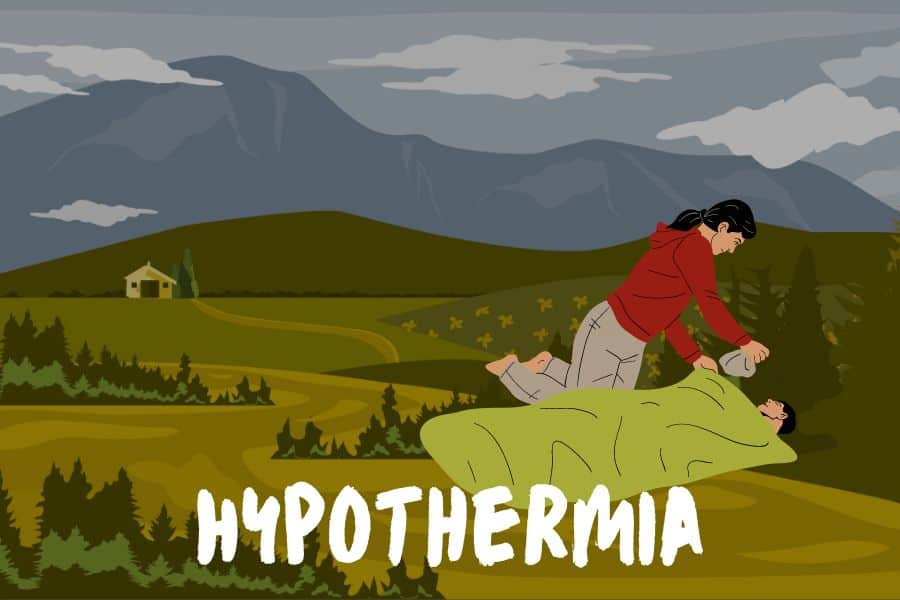
Hypothermia is a dangerous medical condition that occurs when your body loses more heat than it can produce.
It is often caused by prolonged exposure to frigid and freezing cold weather.
In the backcountry, hypothermia is a common hiking injury. It’s, unfortunately, a cause of death for some victims.
Understanding how to prevent and treat hypothermia as a hiker is imperative before you venture out into colder weather conditions.
You must keep your body warm and dry during hiking activities to prevent hypothermia. Exposed skin and wet clothing can cause concern for this type of hiking injury.
Be extra careful around creek crossings and ice-covered water sources.
Layering up is essential to helping you prevent hypothermia because you can keep yourself warm and shed layers as you get too warm.
You don’t want to sweat because wet clothing can slow your body temperature down.
How to treat hypothermia on a hike?
If you start becoming hypothermic, you must get warm and dry as quickly as possible. This might even require you to build a fire.
I keep a pair of insulated running tights, an insulated running shirt, and extra alpaca wool socks in a Ziploc bag just in case I need emergency layers.
Runners wear these clothes alone, so they’ll provide you with warmth in an emergency, and the material is exceptionally lightweight.
I also keep air-activated hand warmers in my pack, too. In the event of hypothermia, focus on warming yourself up, drying off, resting, eating, hydrating, and getting help if it’s an emergency.
Hyperthermia
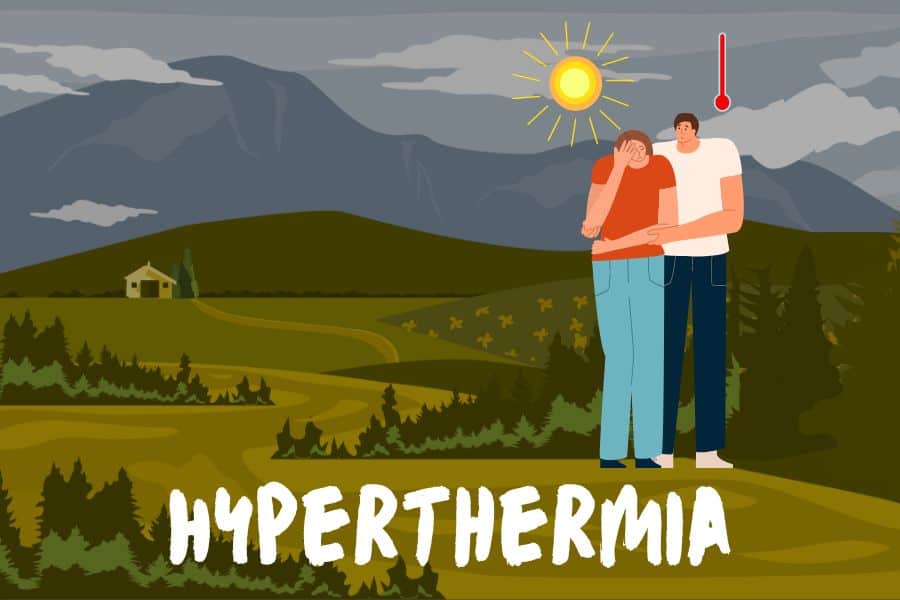
A young family hiking in the California Sierra Nevada Forest died due to hyperthermia and dehydration.
A wife, her husband, and their infant child were among the deaths. It was tragic.
Hyperthermia is the opposite of hypothermia and is just as dangerous to hikers, if not more severe.
Hyperthermia is when your body overheats and cannot cool itself down quickly enough.
It can cause heat sickness, extreme weakness, other heat-related injuries, heat stroke, and even death.
Hiking during hotter days requires extra safety measures.
Preventing hyperthermia is essential when you hike on hotter days. The most important factor for prevention is knowing what the weather forecast will be.
Knowing what hazards will happen beforehand is essential to take safety measures for prevention.
- Take frequent breaks in the shade.
- Take a few sips of water every half hour, whether you’re thirsty or not.
- Wear summer attire that wickers moisture and breaths, such as athletic wear.
- And most of all, avoid hiking on sweltering days with heat advisories in place.
How to treat hyperthermia on a hike?
You must immediately jump into action if you suspect you or someone with you has hyperthermia on the trail. This is a lifesaving situation.
The first thing that should happen is that the victim needs to get out of the direct heat and into a cool shaded spot.
Everything needs to slow down at this point.
Start hydrating and eat something to help fuel the body.
If you take layers off, do it to allow you to cool down, such as a shirt, socks, shoes, hats, etc.
Emergency services should be notified promptly if the temperature is over 104 degrees Fahrenheit.
Dehydration
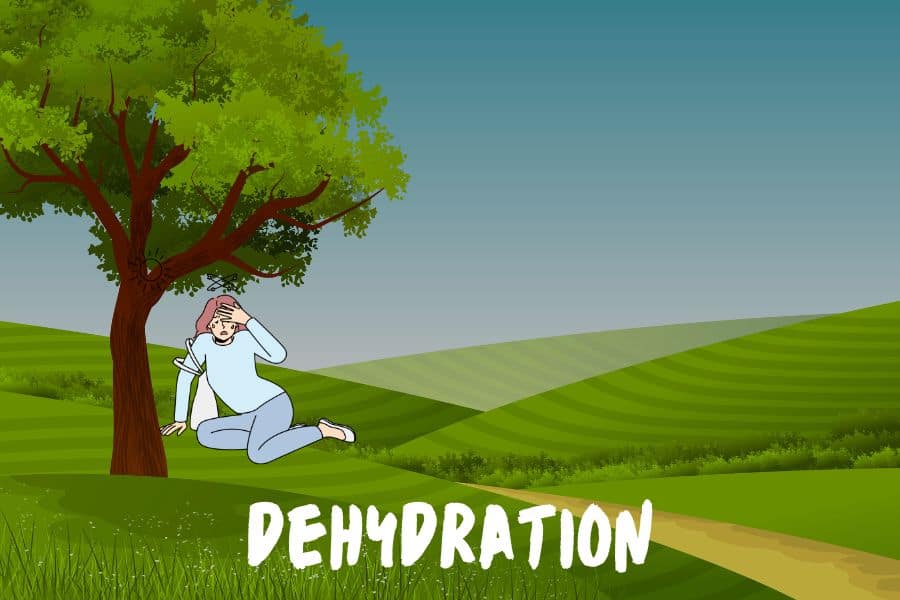
Dehydration is a common hiking injury in the summer and winter.
It’s easy to forget to hydrate adequately when it’s cold outside. I’ve had a lot of close calls with dehydration throughout my hiking experience.
I’m 6’5,” and I get hot quickly. I sweat a lot. I constantly have to hydrate myself to remain free of injury.
Dehydration is when you lose water and sweat from your body due to heat and other activities.
It can be mild, with a headache being the worst system. But frequently, it can be severe, with heat stroke to even death as a result.
Dehydration is a very serious hiking health concern to be aware of.
How to prevent dehydration on a hike?
The best way to prevent dehydration is to hydrate properly.
Because of the amount of sweat I produce, I use regular water and water mixed with electrolyte powder. The electrolytes put salt back into my body that I lose from sweat.
I drink two normal drinks at least once every thirty minutes. I usually snack on a trail bar the entire time I hike, so I have to drink to get it all down my throat.
You should also wear breathable clothing that wicks moisture away.
Finally, you should take breaks in the shade and avoid hiking on the hottest days of the year.
Also see: How Much Water To Bring Hiking: A Guide To Staying Hydrated
How to treat dehydration on a hike?
If you or someone starts to feel overheated, weak, and sickly, and you’re getting a headache while hiking on a hotter day, it might be dehydration.
Dark urine is also a big sign of dehydration.
The best thing to do is hydrate whether you feel thirsty or not. Sit down in a shaded and cooler area and rest while hydrating.
If you have salt and sugary snacks, they should also be consumed to help put salt and fuel back into the body.
Have the victim lie down with their feet propped up and rest for a while. Dehydration is nothing to play around with.
Sunburn
Sunburn occurs when you generate an inflamed reaction to overexposure to UV radiation from the sun.
Some sunburns result in mild pain and discomfort, while others can damage skin conditions or even sun-related illnesses.
In addition, sunburns can lead to cancerous diseases later on in life. Therefore, protecting yourself from dangerous UV radiation from the sun when enjoying the outdoors is essential.
You can prevent sunburns by covering exposed skin with either SPF-15-rated sunscreen or by covering the skin with sun protection clothing.
Try to select hiking trails that are shaded more than others to help reduce exposure to the sun. Don’t hike on days with sun-related danger warnings.
The middle of the day is the most dangerous for sunlight exposure – start hiking earlier to prevent hiking mid-day.
Wear a hat and some sunglasses with UV-ray protection. If you’re out in the sun, cover your exposed skin.
How to treat sunburn on a hike?
Treating a sunburn depends on the type of sunburn you get. If it blisters up and you become ill, you should seek medical attention as quickly as possible.
You will likely need a prescription-strength ointment. Sunburn is nothing to mess around with.
If the sunburn is minor, keep the area cool and out of the sun. Put a medicated cream on it made for sunburns.
Creams with aloe vera are the best for a sunburn. Then, take it easy until the sunburn goes away on its own.
Bug Bites
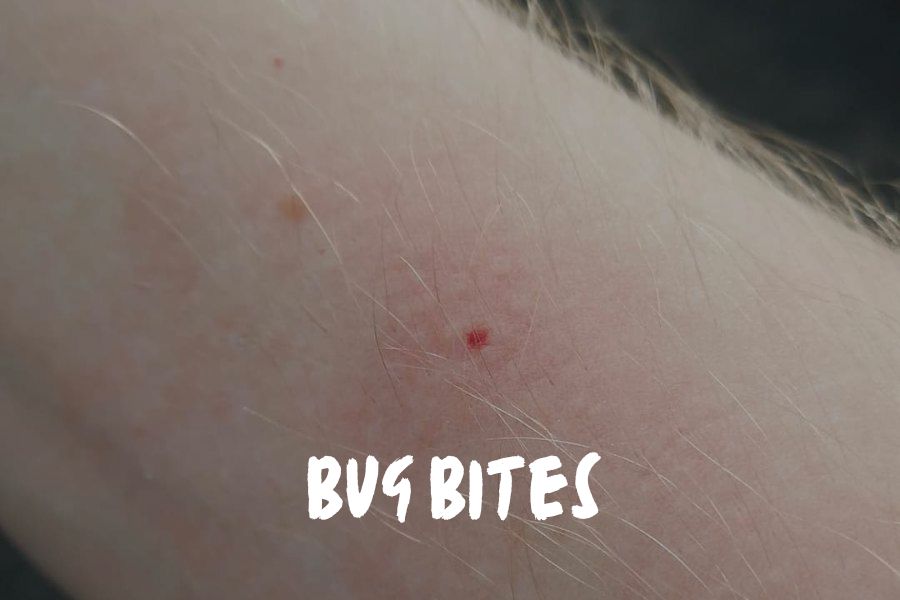
Bugs are often a hiker’s worst enemy. The backcountry is full of bugs that seem to love biting people.
There are mosquitoes, ticks, gnats, spiders, ants, wasps, and bees. Some people have allergic reactions to some bug bites.
For example, I’m externally allergic to bees. I swell up and break out into hives when I get stung.
Buffalo gnats sometimes make my bite area swell up larger than golf balls. Some bug bites, such as those from Black Widow and Brown Recluse spiders, can be severe.
The best way to prevent bug bites is to use three types of insect-repellent sprays.
First, lemon Grass is an excellent natural spray to help mitigate biting flies and gnats. Insect repellent with DEET will prevent most mosquitoes from biting you.
Finally, Permethrin is a potent chemical that should be sprayed on your footwear, clothing, and gear because it will prevent most ticks from getting on you.
Read the instructions before using them.
The trick is reapplying the sprays throughout your hike, but permethrin doesn’t need to be reapplied as it will stay on gear and footwear for quite a while, even if put into a washer.
You should also avoid wet areas and stay on the trail to avoid bug bites.
How to treat bug bites on a hike?
Treat the bites as needed based on their severity if you get bit by a bug.
Mosquitoes and ticks can spread disease, so trying to prevent their bites at all costs is essential.
Check for ticks often and carefully remove them, ensuring that you get their head out, too. Use sting wipes and alcohol-based prep pads to clean the bite areas.
If you get bit and start to have an allergic reaction, an antihistamine or an epi-pen may be required.
In some cases, emergency medical assistance may be required.
Broken Bones

Breaking a bone in the backcountry sounds like a horror movie.
But it’s not a move. It happens, and it happens often. It is a scary situation. It can be challenging to overcome. It can lead to more injuries and even death if not taken seriously.
It can be prevented, but accidents happen, and it’s important to know what to do if you or someone else suffers a broken bone while hiking.
To prevent breaking a bone while hiking, it takes simple common sense.
Watch your step, and don’t do anything hazardous. If you cross a creek, you could slip on a wet stone and fall and break a bone.
If you get close to an edge of a cliff, you can fall and break a bone.
You can slip on muddy flat ground, fall, and break a bone. Being careful, not hiking in poor environmental conditions, and watching your step at all times is the best way to prevent breaking bones in the backcountry.
How to treat bug bites on a hike?
If you or someone else breaks a bone in the backcountry, you need to try to call for help or send someone to get help as soon as possible.
This is especially true if the neck or back is impacted or if it is a compound fracture where the bone is showing.
Never try to put a bone back in place – this often causes more damage than good.
A splint may be necessary to help secure the break area and get the victim to safety.
If you are alone and cannot move, call out for help or blow a whistle until someone hears it. The important thing is that you need to get help.
Must have items in your first aid kit
Taking a first aid kit hiking is an excellent idea. It’s necessary weight because it will help you tend to hiking injuries you may encounter on the trail.
It’s always good to have your medicines in the kit and any special items you need, such as an epi-pen.
Take everyday items for common injuries, such as sting wipes, alcohol prep pads, gauze, band-aids, moleskins, and antibiotic ointments.
One thing I take that most people don’t think about is blood clotting powder.
If you have a significant bleed and are alone, it is essential to tend to it quickly. It is always important to bring only the kind of first aid supplies you know to use.
How to Prevent Hiking Injuries
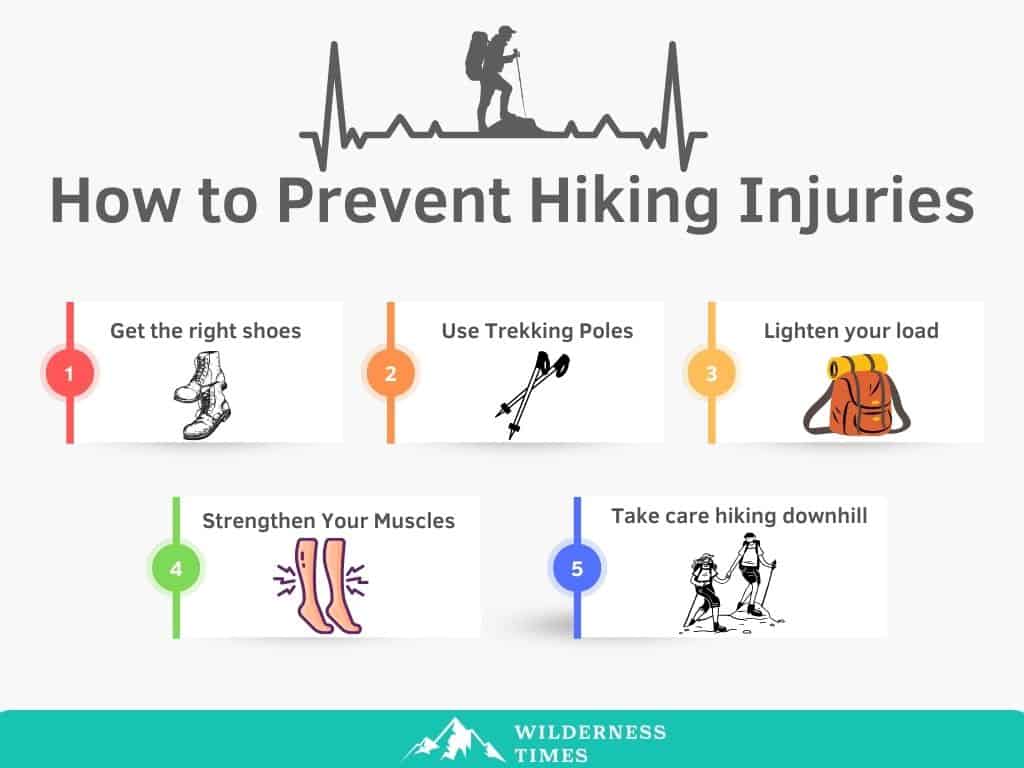
As hikers, we can take many basic ways and safety measures to prevent hiking injuries.
Many of these measures are common sense. Putting safety first before everything else is most important.
Let’s look at some of the best ways to prevent hiking injuries:
Get the right shoes
By buying sturdy outdoor-rated footwear, you can prevent many different hiking injuries related to strains, sprains, slips, and uneven terrain falls.
Get hiking shoes or boots designed for the season you want to hike in.
Consider waterproof boots in the winter to prevent your foot from getting wet.
Try to make sure you get your correct size footwear, too, and break them in before going on any rugged or longer hiking trips.
Use Trekking Poles
Trekking poles are excellent safety gear. You can use them to help balance yourself on the trail.
They help when crossing creeks, going uphill, and coming downhill.
But there is an art to properly using a trekking pole that you should learn about.
I like to carry telescopic trekking poles so that I can fold them up and attach them to my pack when I’m not using them.
But to have them available when I need them most is great because they’ll help prevent me from falling and slipping.
Lighten your load
Weight is a significant factor in many types of hiking injuries. It can cause strains. It can create balance issues that can lead to falling.
The best way to deal with weight is to reduce it.
Only carry what you need, not what you might need on rare occasions. Look to replace heavier items with Ultralight weight items.
Reducing the weight in your backpack will help prevent many hiking injuries you should avoid.
Also see: Knee Pain After Hiking – Causes, Treatments, and Injury Avoidance
Strengthen Your Muscles
If you plan to keep hiking, you should integrate some exercises into your healthy routines.
As I mentioned before, I love cycling. It helps to strengthen my lower body muscles which helps with hiking.
You can also lift weights, run, and do cardio workouts to help you become a stronger hiker. Losing any extra weight you have will also help you hike better.
Hiking is a great way to lose that excess weight, however. And after you’ve hiked for a while and warmed your body up, be sure to stop and stretch for a little bit.
Take care hiking downhill
Hiking downhill is often the time people get hurt.
It’s easier to lose your balance and fall. It’s easier to slip and fall. It’s essential to be extra cautious when hiking downhill.
If you have trekking poles, extend them out longer to allow you to lean back more while going downhill. If you fall, you want to fall back rather than downhill.
If you don’t have a trekking pole, move slowly and almost at a sideways angle while leaning back to help get traction.
Avoid hiking in steep, hilly areas when it’s wet and muddy.
Frequently Asked Questions
What are the most common mistakes first-time hikers make?
Many first-time hikers make the mistake of assuming hiking is like walking in the park.
They don’t bring the right gear or plenty of water. They don’t wear the proper footwear or clothing.
They don’t pay attention to the terrain or the environmental conditions.
Beginner hikers should plan their hikes as much as possible to have a positive and fun experience free of hiking injuries.
What should you avoid when hiking?
Hikers should avoid taking extreme risks when hiking, especially when hiking alone.
Stay on the designated trails and bring the right gear. Dress for outdoor recreation and the season. Avoid areas where danger is likely to occur.
Avoid hiking in conditions where the risk of injury increases. Avoid hiking alone if you can help it.
How do you prevent sprains while hiking?
The best way to prevent a sprain is to wear proper hiking footwear while always watching your step.
Hiking-specific boots that are tightly tied and go above the ankles are best.
Also, the boots need to be your correct size. I like getting my boots one size larger to wear thick wool socks during winter.
A cold and wet foot can also be sprained easier than a warm, dry foot.
What is the most common injury from hiking?
The most common injury that occurs from hiking is blisters. We’re always on our feet. The terrain is rough and uneven.
We get blisters if our boots don’t fit right or our feet are wet. Sometimes we get them simply because we’ve been hiking for a while.
Luckily, they can be prevented easily and treated when they do occur.
To Sum It Up
Blisters are a minor inconvenience that can be prevented. The other significant injuries can lead to life-altering occurrences, but those can be prevented too.
You need to put safety first and follow the tactics above that most of us have experienced throughout our hiking journeys.
Leave the backcountry with great memories and not bad injuries.


